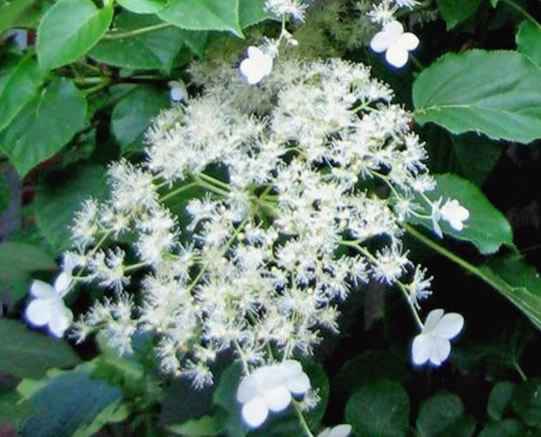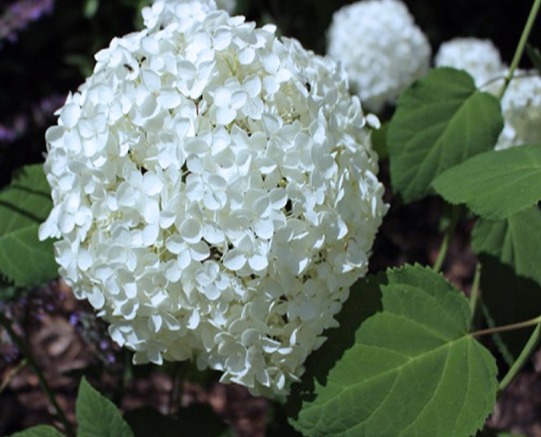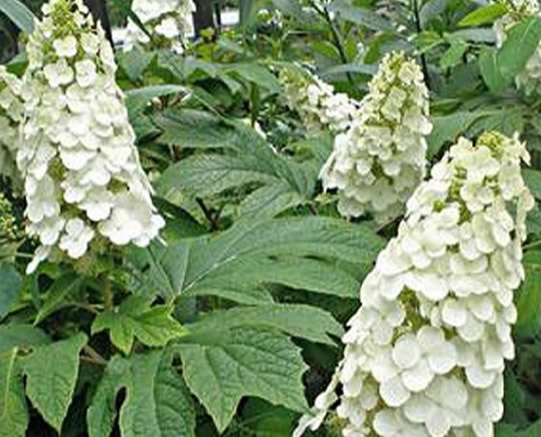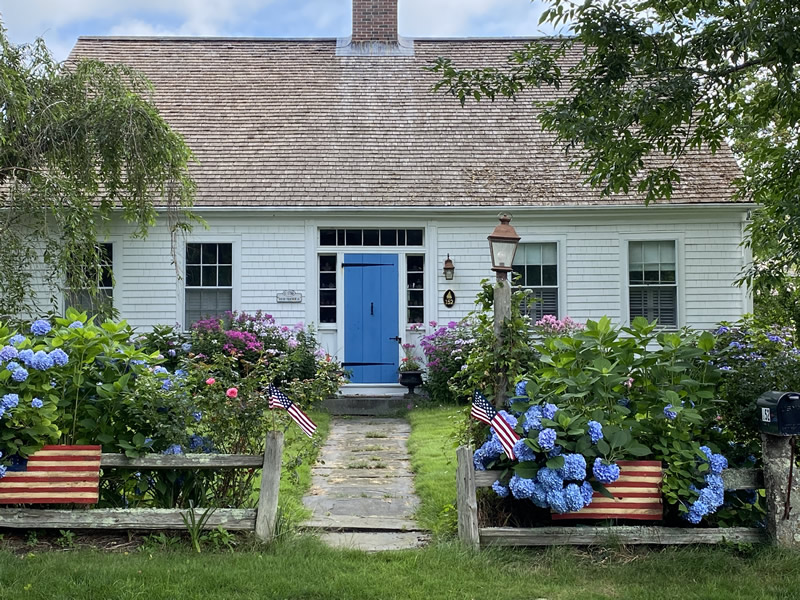Growing Hydrangeas Successfully
The following information was compiled by Mal Condon, past President of CCHS and curator of the hydrangea collection at Heritage Museum and Gardens. Known as the “hydrangea whisperer” for all things hydrangea on the property including the Cape Cod hydrangea Society’s extensive Display Garden and the newest very substantive North American Test Garden.
The Climbers
Hydrangea anomala ssp. petiolaris “The Climbing Hydrangea”
Hardiness Zones: 5 to 9
Plant Size: Can reach 35+ ft. in height when grown around large trees, 10 to 15 ft. height and width can be maintained via pruning.
The H. anomala sub-species petiolaris is the most popular selection of this group of climbers. It is the earliest to bloom in our region (early to mid-June). The large white lace-cap flowers are attractive; the blooming period is short but stunning.
This is a vigorous grower and strong climber equipped with an aerial root system, and can ascend trees, wood-faced buildings, trellises, stone walls, and even brick walls. The plant is best appreciated for its superior physical texture with glossy green leaves in summer and attractive multi-colored stems in winter. It is also cold-hardy and very long lived. Diligent pruning is required to contain this plant.
Old Time Favorites
Hydrangea arborescens “Smooth Hydrangea”
Hardiness Zones: 4 to 9
Plant Size: 2 to 6 ft. height and width
Mostly mophead blooms – large, showy, and ‘heavy’ -characterize this species. ‘ANNABELLE’ has long been the best-known cultivar of this hardy American native and is widely grown owing to superb cold-hardiness and dependable blooming.
Older, legacy cultivars of this species have slender stems that easily bend with summer rains. New varieties – like ‘INCREDIBALL’ – offer more rigid composition and bloom color has been expanded The Cape Cod Hydrangea Society from white and pale lime green to shades of pink and red, and even pale purple.
Good vigorous species when grown in ground. Tolerates full sun in coastal settings; bloom color is better retained with some afternoon shade. Many of the newer H. arborescens introductions are rebloomers – a great characteristic that can be encouraged via pinching spent blooms during early summer.
The Charmers
Hydrangea macrophylla “Big Leaf Hydrangea”
Hardiness Zones: 5 to 9
Plant Size: 2 to 6 ft. height and width
This species is the most loved and widely planted hydrangea. Cultivars with mophead blossoms are dominant but lace-cap varieties offer pleasing texture contrast. H. macrophylla are true charmers with long-lasting blossoms having bold colors ranging from popular blues and purples to pinks, reds, and whites.
They grow well in sunny sites along the coastline, but afternoon shade preserves bloom color. This species typically flowers on ‘old’ wood – buds form in autumn and must survive winter to flower the following summer. Here-in lies the winter- hardiness dilemma. Newer hybrid cultivars offer better cold tolerance with improved stem bud survival and repeat blooming on new growth of the season. The older legacy cultivars are especially winter sensitive and protecting in-ground plantings can be beneficial. The H. macrophylla species can be grown very successfully in containers; this provides an effective means to move and shield plants from direct exposure to winter cold and wind.
More Deserving
Hydrangea paniculata “Panicle (or Hardy) Hydrangea”
Hardiness Zones: 4 to 9
Plant Size: 3 to 10+ ft. height, 3 to 8 ft. width
The H. paniculata species is extremely cold- hardy and long-lived with documented 100- year-old specimens still growing well. Native to the mountainous regions of westernmost Asia, this species is the most sun and drought tolerant hydrangea. They are vigorous growers and flowering develops on “new wood” assuring reliable blooming from mid- July to mid-October. The large panicle-shaped blossoms open in tones of white and mature to pleasing blends of lime green plus shades of pink to mauve and now to an almost red hue on a few recent introductions.
The Oak Leaves
Hydrangea quercifolia “Oak Leaf Hydrangea”
Hardiness Zones: 5 to 9
Plant Size: 5 to 10+ ft. height and width
The mountainous areas of Georgia, Alabama, and Tennessee are home to this American native. Given the inland and upland origin, this woodland species is quite cold-hardy and very drought tolerant once established. Growing under the high dappled shade of tall southern pines, H. quercifolia blooms on ‘old wood’ beginning early June in the south and later in July on Cape Cod.
Flowers are large and pendulous. White is the dominate color with just a couple of cultivars developing pale pink tones. Flowers have varying bloom forms – from quite ‘open’, with sterile and fertile florets – to dense globose heads composed almost totally of sterile florets. Leaves are also large and lobed like the classic oak tree leaf, hence it’s common name. Autumn foliage develops attractive burgundy tones.
Delicate, But Hardy
Hydrangea serrata “Mountain Hydrangea”
Hardiness Zones: 5 to 8
Plant Size: 2 to 6 ft. height and width
The H. serratas appear delicate in composition but are very cold-hardy owing to their origin in the mountainous regions of Western Asia.
They favor shade, especially in the afternoon. Most cultivars produce lacecap flowers, but there are a few mophead bloomers. Flower colors are similar to H. macrophylla but more subdued.
Given their close kinship, breeders are crossing the H. serrata and H. macrophylla species to produce new cultivars with the former’s superior cold-hardiness and the latter’s better bloom characteristics.
Bloom Color Correction
The color of H. macrophylla blossoms – and to a lesser degree, those of H. serrata – are affected primarily by the level of aluminum in the soil and by the pH of the soil. In the presence of aluminum, acidic soil conditions – below 5.5 pH – will favor blue flowers. ‘Sweeter’ soils – pH above 6.0 – will produce pink blossoms.
Aluminum is the key ingredient in bloom color adjustment. Without it, blue flowers will be unattainable. Knowing your soil pH is important as the aluminum can only be assimilated by these species – to produce ‘blue’ – under acidic soil conditions.
Aluminum sulphate is the traditional product used for color ‘correction’ and is readily available. It buffers the aluminum level and is also a good soil acidifier. But aluminum can also be toxic to the plant. ‘Less’ is better and the safest application is simply drenching the base of the plant with a very low concentration of 1 tablespoon of aluminum sulfate per gallon of water. If plant soil is dry, water well before applying the drench solution. Limit applications to just 2 per growing season – April 15 and May 15.
By contrast, if you wish to favor pinks and reds, apply a cup of garden lime (powder form) to the plant base in April and October. Lime is slow acting but in time will raise the pH of the immediate soil and inhibit the plant’s ability to utilize aluminum.
General growing advice
- Keep the mature size of the hydrangea in mind when choosing where to plant it.
- Late spring and early fall are good times to plant.
- Avoid planting on very hot days or very windy days.
- Before digging the hole, water the plant in its container.
- Water it in well after planting.
Pruning
Hydrangea Pruning – Curator-Hydrangea Collection, Heritage Museums & Gardens
To prune hydrangeas effectively it’s important to know the plant’s species – macrophylla, serrata, arborescens, paniculata, quercifolia (the oakleafs), and anomala (the climbers). The reason species is so important to pruning is to know whether the plant flowers on new or old wood. ‘New’ wood is growth of the current season with flowers developing immediately from new growth. Arborescens and paniculatas produce blooms entirely on new wood. ‘Old’ wood is growth from the previous growing season; flowers form in early summer from buds developed the previous autumn. Importantly, these buds must survive the winter before developing into flowers during the following late spring. Macrophyllas, serratas, quercifolias, and the anomalas all flower on old wood.
The new wood arborescens and paniculata species are truly ‘bulletproof’ – extremely cold hardy (zone 4) and reliable annual bloomers. Best pruning time is late fall – November through early December – in our zones 6 & 7.
The old wood quercifolias and anomalas require relatively little pruning. They are both hardy to zone 5 and are best treated as ‘free growers’ left largely to their own growth development. Pruning is a containment exercise – keeping them within ‘bounds’ and removing occasional winter-kill tip sections. Pruning Quercifolias can be left to last – late April – as they are the last species to break bud. For petiolaris, its best to prune after flowering in late June, simply removing spent blooms and errant stems.
Macrophyllas and serratas species have similar flowers with their distinctive lacecap and mophead bloom forms. Mopheads are identified by their full, roundish heads of large petals; lacecaps have tiny fertile flowers in the centre of the bloom with an outer border of larger sterile petals. Both species respond to the same pruning timing and techniques. Macrophyllas are the most popular hydrangea, but they are the least cold-hardy of the species and often require some supplementary winter protection to insure bud survival over a long cold winter. The serratas, though typically more delicate in physical stature, are more cold hardy.
Dead or ‘sun-burned’ blooms can be removed just after flowering. This actually encourages successive blooming on selected varieties that possess this repeat blooming characteristic. The primary pruning time is April; spent blooms and winter-killed tip stem sections can be cut back to the first strong, healthy pair of buds lower down the stem. Aging wood, with exfoliating (peeling) bark, should be removed to encourage the production of new and more floriferous replacement growth. These stems can be cut back cleanly to the ground in late winter when it’s easier to get inside the plant’s base. For newly established plants – 3 gallon and under container size – only minor pruning is necessary for the first year or two. Late spring frosts can be particularly damaging as the tender unfurling leaves of new bud growth is especially susceptible. Prune back damaged stems to just above the first live pair of buds on healthy wood.











